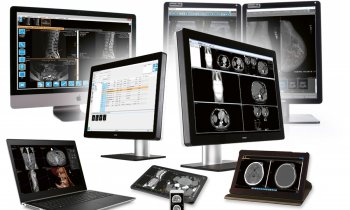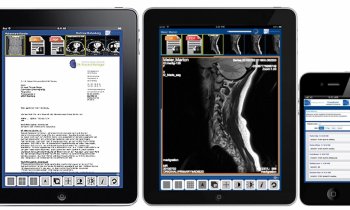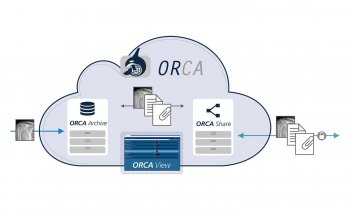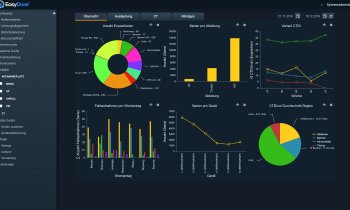Single image/data management system integrates major medical fields
IMPAX Enterprise - a single image and data management system that draws together radiology, cardiology, orthopaedics, and women's care.
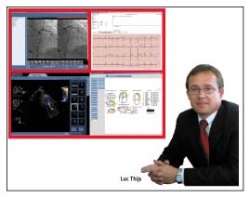
IMPAX Enterprise - a single image and data management system that draws together radiology, cardiology, orthopaedics, and women’s care as the building blocks of an electronic medical record (EMR) - will be shown by Agfa’s HealthCare Business Group at this year’s RSNA.
This system combines IMPAX PACS 6.0 (Picture Archiving and Communication System), IMPAX RIS (Radiology Information System), SMMS (Solution Monitoring & Management Services), IMPAX Reporting, IMPAX Auditing and Integration Services.
Using it, medical personnel can use the internet to schedule radiology, cardiology, mammography and other clinical examinations; to access reports, images, and patients’ entire electronic medical records using only a web browser, and they have a single sign-on, integrated work list an adaptive user interface with the ability to read and dictate reports over a LAN or WAN through access to traditional RIS.
IMPAX 6.0, an application for imaging-based planning, interpretation and results distribution, tightly integrated with the IMPAX RIS as a single workflow-based system to serve users inside and outside a health facility.
SMMS (System Monitoring and Management Services) is integrated to continually manage and monitor Agfa’s applications, hardware, operating systems and databases in a hospital. If a problem arises, all those involved with the system are notified and a map is provided to quickly track and resolve the problem, at any time, due to the connection with Agfa’s Global Support Centres.
IMPAX RIS/PACS, for imaging centres and clinics, streamlines and integrates a comprehensive range of radiology, business and clinical information workflow that traditionally were manual or paper based. New innovations include embedded billing workflow, and an integrated Mammography Tracking module.
The systems provide pre-certification workflow, improving speed of insurance verification, authorisation and re-authorisation steps and reduce manual and paper processes, Agfa points out. ‘Embedded document management within the RIS application, allowing quick user access to documents and electronic screening forms, including radiologist access from within the PACS
Single Desktop Integration to Agfa IMPAX PACS and TalkStation speech recognition allowing single log in, work list utilisation and automatic synchronisation between clinical information and images.’
The Agfa Heartlab portfolio
Beyond radiology, other image-intensive departments within the hospital include cardiology, orthopaedics, and surgery. Of these, cardiology presents a special set of challenges, said Luc Thijs, Agfa’s Vice President and Director of Marketing, Radiology & Department Solutions. Cardiology’s moving images produce large data sets and demand a system architecture that supports rapid access, flexible storage, and robust data protection.
‘Information management needs are different between radiology and cardiology. Radiologists do not see a huge quantity of images, and their reports customarily have four or five lines describing problems, diagnosis, and recommendation. In cardiology, there are more direct examinations and a different approach,’ Luc Thijs explained. ‘You work much more with etiopathologies. A cardiologist’s report will have 40 to 50 different kinds of measurements concerning the function, size and shape of the heart, or details about the valves and so on. A cardiologist needs all the data within the image record to make an effective diagnosis.’
With the acquisition of Heartlab, a leading designer and supplier of image and information networks for cardiology, Agfa meets these challenges with the Agfa Heartlab Cardiovascular portfolio, the world’s first fully web-based cardiovascular information system. The new portfolio facilitates accurate cardiology diagnosis from a single point of access and enhances communication through the integration of cardiology, radiology, and the wider enterprise.
‘In the past,’ he continued, ‘cardiology image data was captured by modality equipment and then results were manually written into the patient record. In a typical first generation of digital imaging, you’ll find different echocardiology systems generating cardiac data and images, and you may find a mini PACS for the echo lab. On the cath lab side, you’ll find the same. But there would be no integration. You would not be able to see the data generated in the echo lab and the data generated in the cath lab in the same digital record. And CT? Well, that’s one step beyond!’
The Agfa Heartlab Cardiovascular system provides one uniform PACS combining all cardiac images and information. ‘We take cardiology into digitisation,’ Luc Thijs pointed out. In addition, because cardiologists typically need access to relevant radiology images, the system also provides connectivity for all the different disciplines. ‘Having a unified patient file, with all the images and measurements available, is totally new - in Heartlab.’
02.08.2006
- data management (585)
- economy (1046)
- interoperability (70)
- IT (890)
- PACS (176)
- RIS (62)
- telemedicine (272)
- workflow (491)







